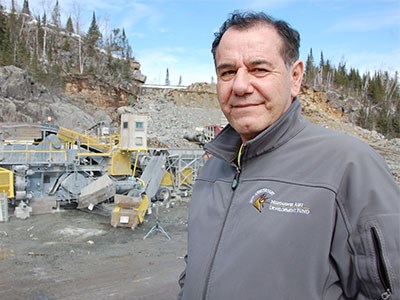Wally Bannon has an interesting dilemma on his hands.
The economic director for Fort William First Nation said there’s no shortage of contracting jobs in the pipeline for the band’s contracting company, Fort William Construction, but he’s facing a critical shortage of skilled manpower.
Two years after the creation of the firm, Bannon said the “opportunities just keep knocking at the door.”
The community of 930, situated across the Kam River from Thunder Bay, owns about $2.5 million worth of heavy equipment used in road building, including a rock crushing unit.
The band developed an aggregate pit and crushing operation on reserve land, and with the help of Sean Main, local contracting consultant, a home-grown workforce has been steadily rebuilding the community’s road network.
But other jobs have since sprung up.
This past spring, the company was handling a $900,000 rock crushing contract for the Ministry of Transportation (MTO) south of Thunder Bay, and he expects more work coming their way.
The MTO has an Aboriginal procurement program that includes a road widening job on Highway 11, north of Nipigon, an estimated $2.5-million job.
Bannon said it would be a step up in from their current project work and involves the removal of a 120-foot-high cliff to widen the highway.
Fort William’s current skilled workforce ranges between 24 and 30, but some upcoming projects that they would like to bid on could require as many as 80 people.
“It was a great lesson for our members over the last two years as we built our roads,” said Bannon. “But once we move off-reserve, we need to meet the conditions of the contracts; the certification, the necessary training and the performance standards.”
Fort William experienced a cash windfall in 2011 with the settlement of a 160-year-old land claim with Canada and Ontario, which delivered $154 million in compensation. It enabled the band council to consider a broad range of economic development and employment opportunities, including the creation of the construction company.
Some of the band’s more skilled members have left to take better-paying jobs with companies in Thunder Bay. It’s why there’s an urgent need to train up more workers.
Bannon’s plan for a $1.5-million training centre remains a work in progress.
The band is eyeballing an industrial building at the former Abitibi Mission Mill on reserve land for conversion into classrooms and shops with simulators and various pieces of heavy equipment.
The business plan is complete and Bannon intended to meet this spring with government funding agencies to develop a financing package.
“Now that we’ve done contracts and are doing contracts, it just strengthens our case.”
It is part of a larger strategy to make Fort William a regional training ground for Aboriginal youth to seek careers in mining and construction.
“What I have on staff now are basically my best people. In order for me to go outside with what I have right now, I need to train more people. I’m only held back by my capacity.”
Bannon said he’s met with North American Palladium, Noront Resources; Enbridge, operators of the Dorion wind farm; Union Gas, Ontario Power Generation, Resolute Forest Products, Lafarge, and Miller Paving about possible road building, rock crushing, and aggregate supply contracts.
He’s even been asked to consider a road development project on a reserve in northern Minnesota.
“Those kinds of opportunities continue to come through the door.”
Fort William has also struck a joint venture partnership with True Grit Consulting to create a new environmental engineering company, Oshki-Aki.
“Many of the projects dealing with mines, transmission and energy projects have an environmental component,” said Bannon.
He’s further taken his message to educators involved with training Aboriginal people for future Ring of Fire transportation infrastructure-related jobs, hoping that they will buy into his training model.
“The Ring of Fire communities don’t have that capability, so we would like to develop partnerships so they have people in place to do it when they build that road.”




